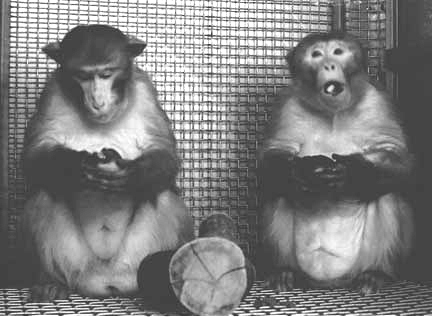 |
> MORAL MOTIVATION OR INTENT (NEUROPHYSIOLOGY AND PSYCHOLOGY)
> NON-HUMAN EXPRESSIONS OF SYMPATHY
 In an effort to understand the nature of such apparent sympathy, Jules Masserman (1963) investigated how macaques responded to other monkey's suffering in a laboratory environment. How would they behave if they knew that securing food would give an electric shock to another monkey? Masserman's monkeys often prolonged their hunger rather than administer a painful stimulus. One monkey refrained from taking food for twelve days. Responses showed several patterns. Self-starvation was more likely in monkeys that had themselves experienced electroshock as a subject. Sacrificial behavior was not biased towards members of higher dominance rank, but was slightly stronger for cagemates (although not statistically significant). Visual contact, even without auditory cues, seemed sufficient to induce the response. The monkeys' behavior seemed to reflect an understanding of another's pain, as well as strong aversity to causing such suffering. (Research ethics no longer allow such experiments.)
In an effort to understand the nature of such apparent sympathy, Jules Masserman (1963) investigated how macaques responded to other monkey's suffering in a laboratory environment. How would they behave if they knew that securing food would give an electric shock to another monkey? Masserman's monkeys often prolonged their hunger rather than administer a painful stimulus. One monkey refrained from taking food for twelve days. Responses showed several patterns. Self-starvation was more likely in monkeys that had themselves experienced electroshock as a subject. Sacrificial behavior was not biased towards members of higher dominance rank, but was slightly stronger for cagemates (although not statistically significant). Visual contact, even without auditory cues, seemed sufficient to induce the response. The monkeys' behavior seemed to reflect an understanding of another's pain, as well as strong aversity to causing such suffering. (Research ethics no longer allow such experiments.)
 In 2008 Frans de Waal performed a related study on capuchin monkeys, involving food rewards rather than painful stimuli. The capuchins were presented with two options: one selfish and one that provided food to themselves and also to a nearby monkey. The monkeys chose the prosocial option when the other monkey was visible and familiar, and so long as the other monkey did not receive a larger portion of food (de Waal, Leimgruber & Greenberg, 2008).
In 2008 Frans de Waal performed a related study on capuchin monkeys, involving food rewards rather than painful stimuli. The capuchins were presented with two options: one selfish and one that provided food to themselves and also to a nearby monkey. The monkeys chose the prosocial option when the other monkey was visible and familiar, and so long as the other monkey did not receive a larger portion of food (de Waal, Leimgruber & Greenberg, 2008).
|

 |